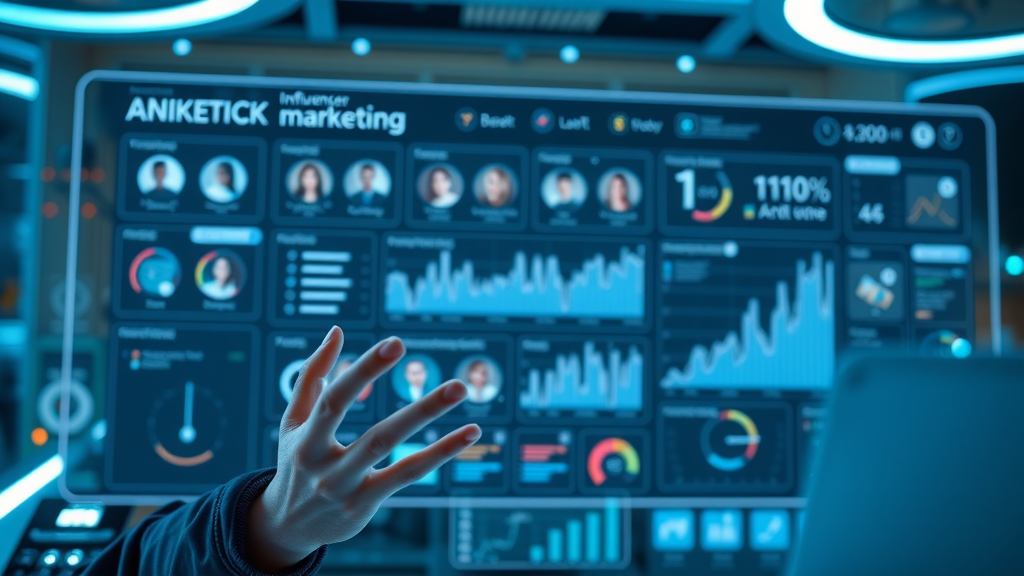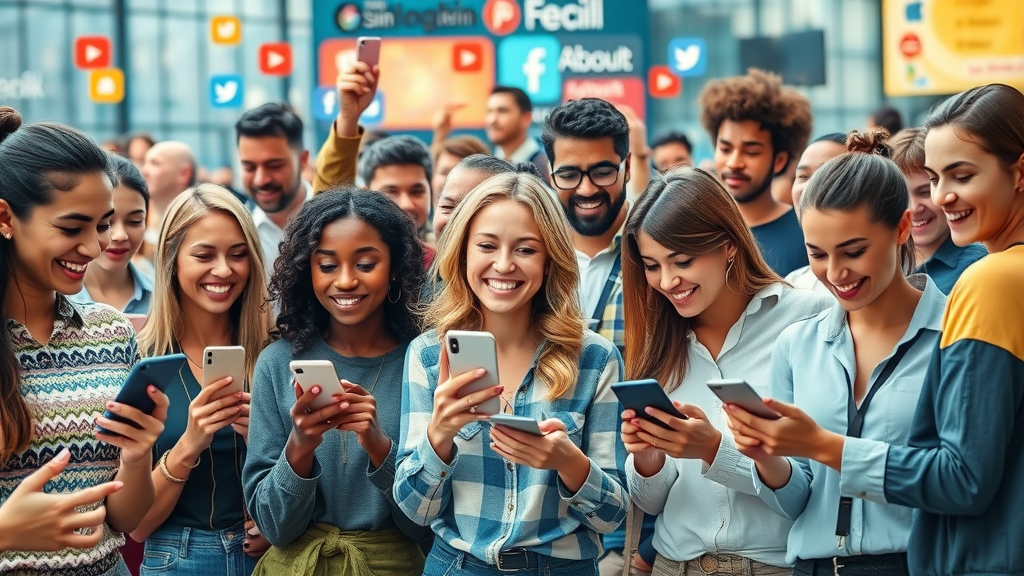Did you know that influencer marketing has driven over $16 billion in global spending in 2024, outpacing traditional social media marketing for the first time? If you’re searching for a powerful way to grow your brand, connect authentically with audiences, and stay ahead in the ever-changing digital marketing landscape, influencer marketing could be the breakthrough you’ve been waiting for. In this comprehensive guide, we’ll break down the latest stats, essential strategies, and actionable steps so you can harness the potential of influencer collaboration—no matter your industry or business size.
Influencer Marketing: The Stats That Matter (Opening Hook)
The numbers tell a compelling story: influencer marketing has jumped to the forefront of digital strategy, with brands spending more on influencer partnerships than on traditional social media marketing campaigns. In 2024, global spending topped $16 billion, signaling a clear shift in how businesses invest in content creation, engagement rate optimization, and authentic connections. This new era isn’t just about reach—it’s about resonance.
What’s fueling this growth? Increasingly, audiences are turning to trusted media influencers for product and service recommendations, and brands are seeing higher ROI from well-targeted influencer marketing campaigns. Today, even micro influencers with modest follower count can deliver engagement rates that rival mega influencers, thanks to hyper-targeted content creation and genuine audience relationships. From beauty influencer campaigns to tech launches, influencer marketing hub strategies are proving essential for brands hoping to reach new heights in 2024.

Explore how influencer marketing drives over $16 billion in global spending in 2024—surpassing traditional social media marketing spend for the first time.
What You’ll Learn
- What influencer marketing is—and isn’t
- How to leverage influencer marketing strategy for different business goals
- Types of influencers: micro, macro, mega
- Best practices for influencer marketing campaigns
- The ROI of influencer marketing
- How to choose an influencer marketing platform
- Key metrics: follower count, engagement, conversion
- Expert insights and actionable tips
Understanding Influencer Marketing
Defining Influencer Marketing in the Modern Social Media Landscape

Influencer marketing is more than just sponsored posts on social media; it's a dynamic blend of content creation and authentic audience engagement that taps into the established trust social media influencers have with their followers. Unlike random advertisements, influencer marketing leverages the credibility of media influencers—people who have built communities around niche interests or lifestyles—to recommend products or services in a way that feels organic and persuasive. With the rise of platforms like Instagram, TikTok, and YouTube, even micro and macro influencers are able to impact consumer decisions on a personal level.
True influencer marketing is not just about follower count or splashy campaigns. It's about finding the right fit between brand and influencer, ensuring that their values align and their audience matches your target demographic. Whether you're working with a tech blogger, a beauty influencer, or a social media lifestyle guru, an effective influencer marketing strategy focuses on meaningful collaborations that put creative, user-driven content creation at the forefront. This new model has redefined how brands approach digital marketing and made influencer marketing an essential component of well-rounded marketing campaigns.
Why Influencer Marketing is a Core Marketing Strategy
For brands aiming to break through the noise of content-saturated feeds, influencer marketing is quickly becoming indispensable. The personal connection influencers have with their communities offers a level of authenticity that traditional media marketing simply can't match. Brands utilizing influencer marketing strategies are not only seeing an uptick in engagement rates but also a measurable increase in conversions—thanks to the ability of social media influencers to build trust and credibility. This impact is especially pronounced in sectors like beauty, tech, and lifestyle, where recommendation from an influencer can drive product adoption at scale.
Incorporating influencer marketing campaigns into your marketing strategy doesn't just improve reach—it creates conversations and communities around your brand. Influencer collaboration allows brands to tap into new audience segments and helps drive user-generated content that feels real and relatable. When paired with strong content creation and a keen eye for analytics, influencer marketing becomes a foundation for sustainable growth, customer loyalty, and brand advocacy in the digital age.
As you refine your influencer marketing approach, it’s also valuable to explore proven social media marketing strategies that drive real growth. Integrating these tactics can help amplify your campaigns and ensure your brand message resonates across multiple channels.
How Influencer Marketing Differs from Traditional Marketing Campaigns
Traditional marketing campaigns often broadcast a generic message to a wide audience, relying heavily on repetition and brand recognition. Influencer marketing, by contrast, thrives on personal storytelling, niche targeting, and content collaboration. Influencers act as trusted intermediaries, shaping perceptions and encouraging followers to engage, share, or purchase based on authentic experiences.
Unlike standard media marketing strategies, influencer marketing is highly adaptable—brands can test different partnership models, content creation styles, and key messaging until they find what resonates. This flexibility makes influencer marketing campaigns ideally suited for brands seeking measurable engagement rates and tangible ROI. The days when marketing meant simply buying ads are over; today's most successful influencer marketing strategies integrate creativity, data-driven decisions, and real-time audience feedback.
"Influencer marketing isn’t just a trend—it’s rapidly becoming the foundation of digital marketing strategy for brands aiming to achieve authentic engagement."
The Different Types of Influencers and Their Impact
Micro Influencers vs. Macro Influencers vs. Mega Influencers
Understanding the different types of influencers is essential for crafting a successful influencer marketing campaign. Micro influencers (typically under 50,000 followers) often boast the highest engagement rates, offering access to tight-knit, highly responsive communities. Macro influencers (ranging from 50,000 to 1 million followers) often combine broad reach with specialized content creation skills, making them suitable for larger product launches. Mega influencers (over 1 million followers), including celebrities and top-tier social media influencers, offer massive exposure, but at a much higher typical cost and with varying levels of audience engagement.
Selecting between micro, macro, and mega influencers depends on your marketing objectives. If your influencer marketing strategy focuses on authenticity and driving niche engagement, micro or macro influencers may yield better results than mega influencers, whose audiences are more diverse. Successful influencer marketing often blends these types of influencers for layered campaign impact—leveraging both reach and resonance across multiple platforms.
| Type | Follower Count Range | Average Engagement Rate | Ideal Use Case | Typical Cost Per Post |
|---|---|---|---|---|
| Micro Influencer | 1,000–50,000 | 4–8% | Niche product launches, local campaigns | $100–$500 |
| Macro Influencer | 50,001–1,000,000 | 2–5% | National brand awareness, sweepstakes | $1,000–$10,000 |
| Mega Influencer | 1,000,001+ | 1–2% | Product launches, global reach | $10,000+ |
Choosing the Right Types of Influencers for Your Brand

Your selection of influencers should align with your marketing goals, target audience, and budget. Begin by analyzing which types of influencers have the follower count and engagement rates suited to your needs. For emerging brands, micro and macro influencers often offer the most value—and can drive higher engagement with unique content creation and audience targeting capabilities. Mega influencers can amplify reach for established brands or global campaigns, but require bigger investment and careful vetting to ensure brand-fit and results.
When evaluating potential influencer partnerships, consider their content creation style, core audience demographics, and history of successful influencer marketing campaigns. Leverage analytics tools to assess authenticity and audience quality. A balanced influencer marketing strategy often includes a mix of influencer tiers, allowing for strategic activation across social media marketing platforms and content formats.
How Social Media Influencers Shape Consumer Decisions

Social media influencers have become essential decision-makers in today's digital shopping experience. Consumers trust personal recommendations from influencers more than traditional advertising, particularly when it comes to beauty influencer strategies, tech gadgets, or lifestyle choices. An influencer’s endorsement often leads to increased search interest, product trials, and conversions—demonstrating the power of relatable, well-made content creation.
Effective influencer marketing leverages these trusted relationships, positioning products or services as natural additions to an influencer’s lifestyle rather than forced promotions. Measurable impacts include higher engagement rates, enhanced shareability across popular social platforms, and the kind of viral momentum that traditional media marketing can’t replicate. This transformative capability is why brands view influencer marketing as both a conversion driver and a crucial marketing campaign cornerstone.
Developing an Effective Influencer Marketing Strategy
Step-by-Step Guide to Building Your Influencer Marketing Campaigns
- Setting objectives for your influencer marketing strategy
- Identifying relevant media influencers
- Crafting compelling content creation briefs
- Measuring outcomes and ROI

To create a successful influencer marketing campaign, first define clear objectives—whether it’s building brand awareness, launching a product, or driving conversions. Next, hunt for media influencers whose audience aligns with your target market, paying close attention to engagement rates, follower count, and content creation relevancy. Once you’ve shortlisted influencers, build detailed briefs that allow both creative freedom and alignment with campaign messaging, ensuring collaboration is authentic and on-brand.
Tracking campaign performance is crucial. Use analytics from both your influencer marketing platform and native social media insights to measure KPIs like engagement, conversion rates, and ROI. A continuous feedback loop—where you review data, adjust strategies, and experiment with different types of influencers—ensures your approach remains current, competitive, and impactful in the fast-paced influencer marketing hub ecosystem.
Content Creation and Collaboration: Best Practices for Successful Influencer Marketing
The lifeblood of influencer marketing is content creation. Successful influencer collaborations happen when brands trust creators to interpret campaign goals through their own unique lens while offering clear brand guidelines and objectives. This balance enables social media influencers or content creators to deliver authentic, audience-relevant messaging that aligns with brand identity. Brands leading the influencer marketing hub often provide resources—style guides, approved messaging, story ideas—to inspire content but avoid micromanaging creative choices.
Open communication, shared vision, and regular feedback loops ensure each influencer marketing campaign meets both brand and influencer goals. Document successes, refine briefs, and adapt your influencer marketing strategy as you discover which types of influencers and collaboration models resonate best. The key is to treat influencers as partners instead of just marketing channels—resulting in content that drives ROI and builds community for the long run.
"A successful influencer marketing campaign thrives where brand vision meets influencer creativity."
Common Pitfalls in Influencer Marketing and How to Avoid Them

Even the most well-intentioned influencer marketing campaigns can run into pitfalls. One common mistake is prioritizing follower count over genuine engagement or audience relevance—leading to wasted spend and underperforming campaigns. Fake followers, misaligned partnerships, or insufficient vetting can jeopardize your campaign’s success. Brands may also falter by exerting too much creative control, resulting in inauthentic content or breaking trust with both influencer and audience.
Avoid these mistakes by using data-driven influencer marketing platform tools for audience analysis, engagement rate tracking, and authenticity checks. Set measurable goals and maintain an open line of communication with influencers. Regular reporting, campaign optimization, and learning from both wins and challenges keep your influencer marketing strategy effective and adaptable.
How to Select the Right Influencer Marketing Platform
Criteria for Evaluating Influencer Marketing Platforms
- Audience targeting capabilities
- Analytics and reporting features
- Influencer database quality
- Ease of campaign management
Choosing the right influencer marketing platform can make or break your campaign’s effectiveness. Look for tools that offer advanced audience targeting capabilities, granular analytics, and robust influencer databases with engagement rate and follower count details. Optimal platforms provide seamless campaign management, tracking every step from collaboration and content creation to ROI measurement.
A great influencer marketing hub not only matches brands with relevant social media influencers, but also offers fraud detection, communication tools, and automated reporting dashboards. Test a few different platforms to find the one that aligns best with your campaign size, industry, and content creation needs. The right platform transforms influencer marketing from a guessing game to a predictable, data-driven strategy.
Top Influencer Marketing Platforms for 2024

The influencer marketing platform landscape has expanded in 2024. Top platforms include Aspire, CreatorIQ, Upfluence, and GRIN—each offering specialized features for campaign automation, influencer discovery, audience analytics, and seamless payment processing. Platforms like Influencity and Traackr cater to specific industries or campaign sizes, making them popular social tools for both startups and established brands.
When choosing your influencer marketing platform, evaluate integrations with your existing marketing hub, social media analytics features, and the platform’s ease of use. Prioritize systems with a proven record in successful influencer marketing campaigns, and leverage demo versions to test before committing long-term. Comprehensive support and regular feature updates are essential for keeping pace with evolving influencer trends.
| Platform | Best For | Key Features | Pricing Model |
|---|---|---|---|
| Aspire | SMBs to Large Brands | Influencer database, content creation, ROI analytics, product gifting | Subscription (custom) |
| CreatorIQ | Enterprises | Advanced analytics, audience insights, automated workflows | Custom enterprise pricing |
| Upfluence | E-commerce Brands | Social listening, affiliate marketing integration, robust reporting | Subscription (tiered) |
| GRIN | Direct-to-Consumer | Influencer discovery, campaign management, e-commerce integration | Custom/monthly |
Measuring Influencer Marketing ROI and Success Metrics
Key Metrics: Engagement, Reach, Conversions, Follower Count

Measuring the impact of your influencer marketing strategy should go beyond vanity metrics. Focus on engagement rate, conversion metrics, total reach, and follower count growth when evaluating campaign performance. Engagement rates—likes, comments, shares, and saves—signal audience connection. Conversion metrics track direct actions such as sales, sign-ups, or downloads. Follower count growth following a campaign highlights brand exposure and interest.
Leverage platforms and social media analytics to compare performance across types of influencers and campaign styles. Evaluate quality of engagement over quantity, and always cross-reference your goals with reported outcomes. Some of the most successful influencer marketing campaigns use a blend of micro and macro influencers to optimize both reach and ROI, adjusting strategies based on data-led insights for continuous improvement.
Real-World Examples of Successful Influencer Marketing Campaigns
- Beauty influencer marketing campaigns: Skincare brands collaborating with micro influencers on TikTok have reported up to 20% sales increases.
- Tech influencer strategies: Smartphone launches leveraging YouTube macro influencers see millions in global impressions and strong conversion rates.
- Fashion and lifestyle influencer campaign outcomes: Apparel brands driven by aesthetic Instagram content creation often achieve viral challenge participation and a surge in organic follower growth.
Case studies repeatedly show that authentic influencer collaboration, creative content, and careful platform selection drive measurable results. Brands that align influencer marketing campaigns with broader marketing strategies see not just campaign success, but long-term community growth and loyalty.
Case Study: How One Brand Boosted Sales with Influencer Marketing (Video Available)
Integrating Influencer Marketing with Your Broader Marketing Strategy
Combining Influencer Marketing and Social Media Marketing

The best marketing strategies integrate influencer marketing with traditional social media marketing, amplifying messaging across channels. Cross-promotion drives awareness, while influencer-generated content can be repurposed for paid ads, email campaigns, or even retail partnerships. Brands that build integrated campaigns maximize their media marketing impact, blending the credibility of social media influencers with the broad reach of multi-channel distribution.
Encourage influencers to use brand-specific hashtags, participate in live events, and co-create content that launches simultaneously on both their accounts and your official channels. This strengthens message consistency and ensures every touchpoint resonates with your desired audience. Effective omnichannel influencer marketing campaigns create stronger brand memory, higher conversion opportunities, and measurable uplift in overall marketing campaign performance.
How Influencer Marketing Fits into Omnichannel Marketing Campaigns
Omnichannel marketing campaigns aim to deliver a unified brand experience across all customer touchpoints—both digital and offline. Influencer marketing brings an authentic, word-of-mouth component to this strategy by connecting with consumers in the hyper-personalized realms of social media and content platforms. Used effectively, influencer marketing campaigns can anchor product launches, seasonal promotions, and brand storytelling efforts across every major marketing platform.
By syncing influencer marketing strategy with CRM data, paid campaigns, and physical events, brands give consumers a seamless journey from discovery to purchase. In 2024, leading brands are using influencer marketing hub platforms to coordinate messaging, measure attribution, and optimize touchpoints—making influencer marketing core to the modern omnichannel playbook.
Expert Panel: The Future of Influencer Marketing in 2024 and Beyond (Video Available)
People Also Ask
What does influencer marketing do?
Influencer marketing uses trusted voices to endorse products, increase brand awareness, and drive conversions through social media and digital platforms.
How much do influencers get paid for marketing?
Influencer pay varies by follower count, engagement, and platform: micro influencers may earn $100–$500 per post, while mega influencers can command $10,000+ per collaboration.
What are the 3 R's of influencer marketing?
The 3 R's stand for Relevance, Reach, and Resonance—crucial for evaluating influencers and campaign fit.
How do I become an influencer marketer?
Become an influencer marketer by building expertise, cultivating a personal brand, connecting with potential collaborators, and staying updated with influencer marketing trends.

Frequently Asked Questions about Influencer Marketing
- Is influencer marketing effective for B2B brands?
- How can I measure the ROI of influencer marketing?
- What legal considerations are involved?
- How do I spot fake followers or engagement?
Key Takeaways: Is Influencer Marketing Right for You?
- Influencer marketing offers unique credibility and authentic reach.
- Careful strategy and platform selection are key to success.
- Measuring impact is essential for continuous improvement.
Conclusion: Embrace Influencer Marketing as a Transformative Marketing Strategy
For more information read The Ultimate Guide to Social Media Marketing: Strategy, Platforms, Channels, and Tips to Win, and How to Build a Winning Plan.
Ready to see what influencer marketing can do for your brand? Need Help? Call Digital Media Marketing at 1-586-997-0001.
If you’re inspired to take your marketing to the next level, consider how influencer marketing fits within the broader digital landscape. For a deeper dive into holistic strategies that combine content, branding, and technology, explore how digital marketing as a whole can be the breakthrough your business needs. By understanding the synergy between influencer campaigns and comprehensive digital marketing, you’ll be equipped to unlock new growth opportunities and stay ahead of evolving trends. Let your next campaign be the start of a smarter, more integrated approach to brand success.
 Add Row
Add Row  Add
Add 




Write A Comment